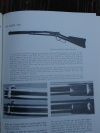
|
Winchester 1892 SRC Earliest Production w/Model 1873 Components |
Every once in a while, we come across a Winchester that is just about off the charts in terms of scarcity. This is a very early Model 1892 Saddle Ring Carbine that was built using Winchester Model 1873 components. The only mention I've ever found of one is in The Winchester Book by George Madis which I remember reading about 25-30 years ago. The story Madis tells of how this small group of carbines came about is one of my personal favorites of the many he shares in his book. In subsequent years, I had the honor to meet Madis and had a couple of incredible conversations with him that lasted for hours on the phone. While I did not know him very well, he was an incredibly generous man so it would only be fair that I share with you guys some things he told me. For starters, I think Madis could have written several more books as The Winchester Book is just a glimpse of what he actually knew. Madis was a big fan of Winchester salesman T.E. Addis, who traveled the globe selling Winchester repeaters. George quoted Oliver Winchester something to the effect that "No Winchester salesman could get more sales, travel faster for the least expense than Addis could. Madis told me that while writing the book, he was given an office at the Winchester plant back and could come and go as he pleased although he had a bit of trouble with the night watchman when he came in late at night. No doubt, he went through a great deal of company records. That Madis was able to locate not only the correspondence between Addis and the Winchester factory ordering these carbines is amazing but to then find the actual guns from the order was truly a remarkable achievement. Remember, this was long before the days of the internet. Madis gives this carbine, which is in the 2,600 serial range, almost an entire page in the Model 1892 chapter. This particular carbine we have is also the 2,600 serial range and just eleven numbers away from the one pictured in the book. Caliber is .44 WCF with a 20" barrel, full magazine, crescent buttplate, saddle ring, and ladder rear sight. This carbine has a Model 1873 barrel but is marked with a different roll die than the 1873. As the roll die for the carbines was also not ready, it appears Winchester used one from the Model 1886 with the forked dashes on the ends of the lines. This barrel is quite a bit thicker and heavier than the standard Model 1892 barrels. The rear sight is a standard Model 1873 rear sight that is graduated from 200-900 yards with the "1873" at the top. Soon afterwards, the "1873" was removed and was left blank. The front sight is also the solid block style used on the Model 1873 and has no insert. It has model 1873 barrel bands as they are for the thicker Model 1873 barrel and have no indentations. Finally, the buttplate is also from a Model 1873 which is notably thicker than what we commonly find on the Model 1892 carbine. Normally, a Model 1892 carbine weighs in at around 5-1/2 lbs but with the added weight of the Model 1873 components, this one weighs in at 6-1/2 lbs. When you pick it up, the extra weight gives the perception that the gun is loaded. It's not, just heavier! This little carbine is completely untouched and is 100% original down to the smallest screw. Overall Condition grades to NRA Antique Fine+ with 50% thinning receiver blue with a perfect wear shadow from the saddle ring. The bolt has 90% original blue, with strong traces of fire blue around the edges of the loading port. Lever shows 10% original case colors in the protected areas just below the frame while the hammer has 70% original case colors. Note the hammer has the earliest pattern with the dipped decorative border which was only used for the first 2-3 years of production. Buttplate has some silvery traces of case colors as well. Barrel and magazine tube retain 60% original blue which ranges from a strong blue in protected areas to a more age darkened blue which is turning to a plum color in the exposed areas...balance is a brown patina. Other than a few small bruises on the right side of the forend, the original walnut wood is in Fine Condition Overall. No chips, cracks, or repairs. Nice mechanics. Bore is Excellent. Bright and shiny. This is the rarest and one of the earliest Model 1892 Winchester carbines you'll ever see. Item# 1809 SOLD |
 |
 |
||
 |
 |
 |
|
 |
 |
 |
 |
 |
 |
 |
 |
 |
 |
 |
 |
 |
 |
||
 |
 |
 |
 |
 |
 |
 |
 |
 |
 |
 |
 |
 |
 |
 |
 |
 |
 |
 |